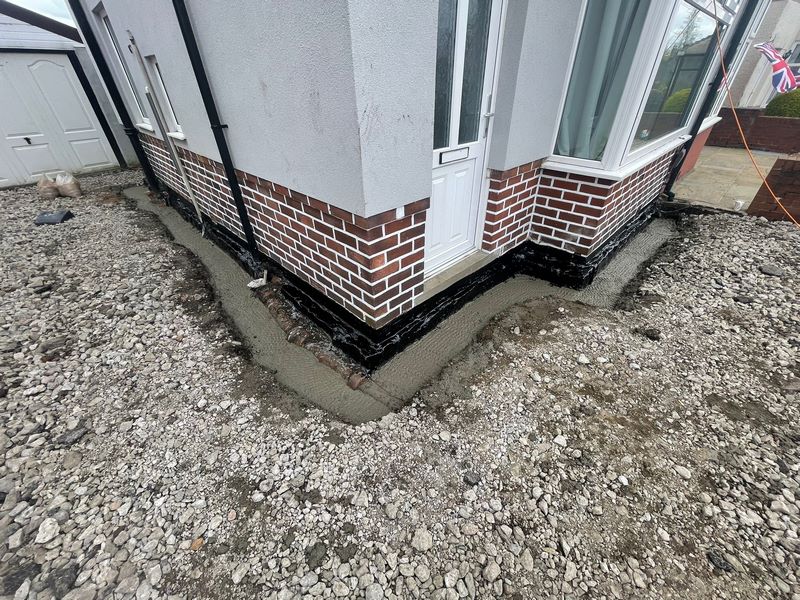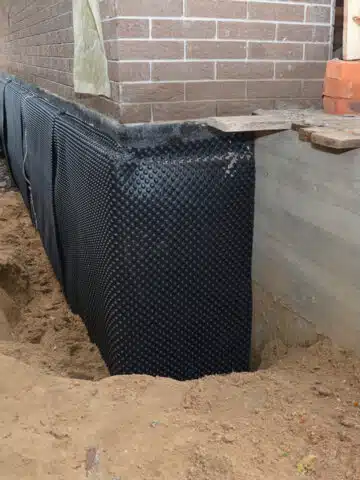The ultimate manual to mould treatment newcastle: Steps from start to finish
The ultimate manual to mould treatment newcastle: Steps from start to finish
Blog Article
Checking Out the Different Techniques and Solutions for Effective Damp Proofing
Dampness in buildings positions substantial challenges to both structural integrity and interior air top quality. Various techniques and solutions have emerged to combat this prevalent concern. From traditional damp-proof membranes to ingenious chemical treatments, each technique offers special advantages. Recognizing these alternatives is crucial for reliable moisture control. Selecting the best solution depends on particular structure conditions and demands, motivating additional exploration into the most effective moist proofing strategies available.
Comprehending the Reasons For Wetness
Although dampness can arise from numerous resources, recognizing these causes is important for effective remediation. Typically, dampness originates from three key resources: increasing wet, passing through damp, and condensation. Rising moist happens when groundwater travels up via permeable materials, such as block or rock, frequently due to a lack of an efficient barrier (damp removal newcastle). Passing through wet is usually caused by external aspects, including roof leakages, malfunctioning seamless gutters, or damaged walls, enabling water to infiltrate a residential property. Condensation, on the various other hand, arises from excess dampness airborne, usually aggravated by inadequate air flow and temperature level distinctions, causing water droplets forming on surfaces. Recognizing these underlying problems is necessary, as each kind of wetness calls for a customized strategy for remediation. Proper evaluation assists in establishing one of the most effective solutions, eventually protecting the architectural stability of a building and improving interior air high quality
Standard Damp-Proof Membrane Layers

Chemical Damp-Proofing Solutions
Chemical damp-proofing options offer a cutting-edge technique to stop moisture breach in buildings. These approaches generally include the application of fluid chemicals that pass through masonry and create a barrier against increasing wet. Generally utilized chemicals consist of silanes, siloxanes, and various other water-repellent agents that react with surface products to produce a hydrophobic layer.The application procedure typically requires exploration holes into the wall surfaces, infusing the chemical option, and permitting it to treat. This approach is specifically useful for older frameworks where typical damp-proof membranes might be not practical. Additionally, chemical damp-proofing can be less turbulent and much more cost-effective than substantial renovation projects.While reliable, these services depend upon correct application and ecological conditions for peak performance. Regular maintenance and surveillance are important to ensure the durability of the damp-proofing treatment. Generally, chemical damp-proofing stands for a flexible choice for securing buildings versus moisture-related damages
Tooth Cavity Wall Building And Construction Methods
Tooth cavity wall surface building and construction strategies offer various benefits, particularly in moisture control and energy effectiveness. By integrating an air gap in between 2 layers of stonework, these wall surfaces successfully reduce water ingress while enhancing insulation. This mix not only safeguards structures from dampness but additionally adds to minimized power usage.
Benefits of Tooth Cavity Walls
When thinking about effective moist proofing methods, the advantages of tooth cavity wall surfaces attract attention prominently. Dental caries wall surfaces include two separate layers, developing an air void that properly lowers wetness infiltration. This layout minimizes the risk of wetness, as the outer wall surface serves as a barrier against rain and water access. In addition, dental caries wall surfaces boost thermal insulation, which adds to energy effectiveness by lowering heat loss. They likewise give audio insulation, aiding to create a quieter indoor setting. Moreover, the air gap permits air flow, which helps in wetness control and decreases the possibility of mold development. These advantages not only boost the general comfort of a building however likewise add to its durability and structural integrity.
Dampness Control Approaches
Effective dampness control approaches are essential in tooth cavity wall building to ensure lasting security against dampness. One main approach involves the consolidation of weep openings, which facilitate water drainage from the cavity, stopping build-up. Additionally, making use of breathable membrane layers can aid manage moisture levels while permitting trapped vapor to escape. Proper positioning of insulation is likewise important, as it should not obstruct water drainage paths. Guaranteeing that the outer fallen leaves of the dental caries wall surface are created with water-resistant materials improves total durability. Regular upkeep checks are important to recognize any kind of blockages or damage early, guarding the framework's integrity. Eventually, a mix of these techniques develops a durable protection versus wetness breach in dental caries walls.
Insulation and Energy Efficiency
Insulation plays a vital role in mould treatment newcastle enhancing power efficiency within cavity wall construction. By including insulating products, these walls develop a thermal obstacle that lessens heat loss and reduces energy consumption. Reliable insulation not just helps maintain a steady indoor temperature yet likewise minimizes the risk of dampness, as it avoids condensation within the wall dental caries. Various strategies, such as using stiff foam boards or mineral woollen, can be used to attain perfect insulation performance. Furthermore, correct installation is important to ensure that gaps and gaps are reduced, which can otherwise jeopardize power performance. Ultimately, a well-insulated cavity wall adds significantly to general sustainability and reduces heating and air conditioning prices for homeowners.
Outside Damp Proofing Approaches
External moist proofing approaches are necessary for protecting structures from wetness seepage. Two efficient methods consist of the application of water-proof membrane layers and the installation of French drains. These options help reduce water buildup and maintain the integrity of structures.
Waterproof Membrane Application
While various methods exist for preventing wetness ingress, the application of water-proof membranes stays a very effective exterior damp proofing strategy. These membranes are commonly made from products such as polyethylene, rubber, or changed asphalt, providing a robust obstacle versus water penetration. The installment process involves applying the membrane to the outside surface areas of structures or wall surfaces, making certain full insurance coverage to stop leakages. Appropriate attachment and securing at joints are crucial to making the most of performance. Water-proof membrane layers can be used in various forms, consisting of fluid layers and sheet membrane layers, enabling versatility based on the certain demands of the framework. This approach not just shields buildings from dampness however additionally enhances their long life and architectural integrity.
French Drain Setup
One effective approach for taking care of groundwater and stopping moisture accumulation around a structure's foundation is the installment of a French drain. This drain system is composed of a trench loaded with gravel and a perforated pipe that redirects surface water far from the structure. Appropriate installment calls for careful preparation, ensuring that the drain slopes away from the structure to help with suitable water flow. In addition, the area of the drainpipe is vital; it must be positioned in locations susceptible to pooling or excess moisture. Normal upkeep, including clearing debris from the crushed rock and guaranteeing the pipeline stays unhampered, is necessary for long-lasting efficiency. Inevitably, a well-installed French drainpipe can substantially reduce the risk of water-related problems in basements and foundations.
Interior Waterproofing Techniques
Interior waterproofing strategies are crucial for shielding a structure's interior from moisture infiltration and possible water damages. These approaches generally entail the application of specialized products and methods designed to develop a moisture obstacle within the framework. One typical strategy is using waterproof coatings or sealers on walls and floorings, which protect against moisture from penetrating surfaces.Additionally, mounting indoor drain systems, such as sump pumps, can effectively handle water buildup in cellars and creep spaces. One more method involves making use of vapor obstacles, which are set up to hinder dampness motion from the ground into living spaces.Moreover, attending to any kind of cracks or voids in walls or foundations with proper sealants assures a thorough protection versus water intrusion. By carrying out these interior waterproofing approaches, property proprietors can greatly decrease the risk of mold development, structural damage, and various other moisture-related problems. Appropriate execution of these strategies is important for lasting protection and building honesty.
Normal Upkeep and Examination Practices
Normal maintenance and assessment techniques are crucial for guaranteeing the long-lasting performance of moist proofing solutions in any kind of structure. Regular checks enable home owners to determine early signs of dampness invasion, such as peeling paint, mold and mildew growth, and mildewy odors. These signs can indicate underlying problems that require instant attention.Inspections ought to be conducted a minimum of every year, concentrating on at risk locations like cellars, creep areas, and exterior walls. During these analyses, residential property owners need to analyze sealers, water drainage systems, and air flow to confirm they function correctly.Additionally, maintaining gutters and downspouts is necessary, as blocked systems can bring about water build-up near the foundation. Carrying out a regular upkeep timetable, along with timely repair services, can substantially expand the life expectancy of moist proofing steps and safeguard the architectural honesty of the building. Proactive steps inevitably add to the overall health and wellness of the living atmosphere.
Frequently Asked Concerns
How Long Does Damp Proofing Normally Last?
The duration of wet proofing efficiency varies, commonly lasting in between 20 to half a century. Elements such as application top quality, ecological conditions, and maintenance practices greatly influence the durability of the damp proofing treatment.

Can I Damp Evidence My Home Myself?
The private considered the usefulness of do it yourself damp proofing. With appropriate research and the right products, it is feasible. Nonetheless, they also recognized the significance of specialist advice to guarantee resilient efficiency and avoid future issues.
What Are the Indications of Inadequate Damp Proofing?
Indications of ineffective wet proofing consist of persistent musty smells, visible mold development, peeling paint, damp patches on wall surfaces, and timber decay - mould removal newcastle. Homeowners need to attend to these issues quickly to stop further damages and health and wellness concerns
Does Damp Proofing Affect Indoor Air Quality?

Just How Much Does Expert Damp Proofing Cost?
Expert moist proofing expenses vary significantly, typically ranging from $1,000 to $5,000 relying on the residential or commercial property's dimension, the extent of the wet issue, and chosen approaches. Each situation needs a customized analysis for precise pricing. Commonly, moisture originates from 3 key resources: rising moist, penetrating damp, and condensation. When considering reliable moist proofing approaches, the advantages of dental caries walls stand out plainly. External wet proofing approaches are essential for protecting structures from dampness seepage. While different approaches exist for preventing moisture ingress, the application of water resistant membranes continues to be a very reliable outside damp proofing technique. Indicators of inefficient moist proofing consist of relentless mildewy odors, noticeable mold development, peeling paint, moist patches on wall surfaces, and wood decay.
Report this page